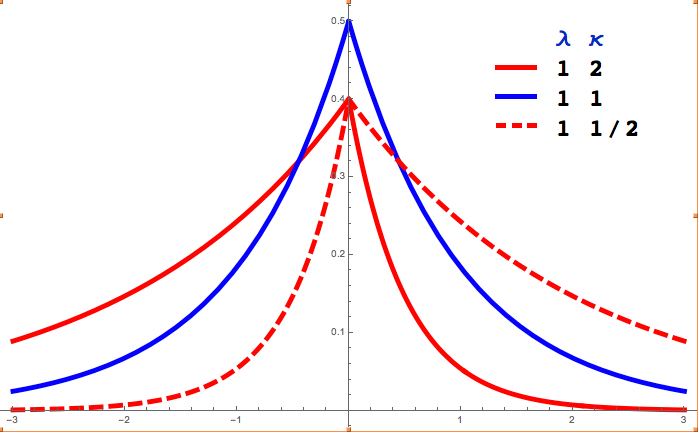PDF (see article) | CDF (see article) | |
 | ||
Parameters m {\displaystyle m} location (real) λ > 0 {\displaystyle \lambda >0} scale (real) κ > 0 {\displaystyle \kappa >0} asymmetry (real) Support x ∈ ( − ∞ ; + ∞ ) {\displaystyle x\in (-\infty ;+\infty )\,} Mean m + 1 − κ 2 λ κ {\displaystyle m+{\frac {1-\kappa ^{2}}{\lambda \kappa }}} Median m + ( κ / λ ) log ( 1 + κ 2 2 κ 2 ) {\displaystyle m+(\kappa /\lambda )\log \left({\frac {1+\kappa ^{2}}{2\kappa ^{2}}}\right)} | ||
In probability theory and statistics, the asymmetric Laplace distribution (ALD) is a continuous probability distribution which is a generalization of the Laplace distribution. Just as the Laplace distribution consists of two exponential distributions of equal scale back-to-back about x = m, the asymmetric Laplace consists of two exponential distributions of unequal scale back to back about x = m, adjusted to assure continuity and normalization. The difference of two variates exponentially distributed with different means and rate parameters will be distributed according to the ALD. When the two rate parameters are equal, the difference will be distributed according to the Laplace distribution.
Contents
Probability density function
A random variable has an asymmetric Laplace(m, λ, κ) distribution if its probability density function is
where s=sgn(x-m), or alternatively:
Here, m is a location parameter, λ > 0, is a scale parameter, and κ is an asymmetry parameter. When κ = 1, (x-m)s κs simplifies to |x-m| and the distribution simplifies to the Laplace distribution.
Cumulative distribution function
The cumulative distribution function is given by:
Characteristic function
The ALD characteristic function is given by:
For m = 0, the ALD is a member of the family of geometric stable distributions with α = 2. It follows that if
is also an ALD characteristic function with location parameter
and the new skewness parameter κ obeys:
Moments, mean, variance, skewness
The n-th moment of the ALD about m is given by
From the binomial theorem, the n-th moment about zero (for m not zero) is then:
where
The first moment about zero is the mean:
The variance is:
and the skewness is:
Generating asymmetric Laplace variates
Asymmetric Laplace variates (X) may be generated from a random variate U drawn from the uniform distribution in the interval (-κ,1/κ) by:
where s=sgn(U).
They may also be generated as the difference of two exponential distributions. If X1 is drawn from exponential distribution with mean and rate (m1,λκ) and X2 is drawn from an exponential distribution with mean and rate (m2,λ/κ) then X1 - X2 is distributed according to the asymmetric Laplace distribution with parameters (m1-m2, λ, κ)
Entropy
The differential entropy of the ALD is
The ALD has the maximum entropy of all distributions with a fixed value (1/λ) of
